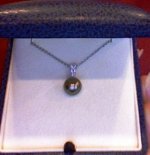I think the qualifier for Orient is movement. The oil slick effect appears when light is refracted back at the viewer from not only the surface of the pearl, but also from inside the crystalline material as well. As you view the pearl under different light sources, Orient will shimmer and react to different wavelengths of light, creating the illusion that the color "slides" or "plays" over the surface. The word iridescence means exactly the same thing- that color and hue will change or shift proportionately to the angle from which it is viewed depending upon the light source.
Overtone is somewhat stationary... For example, on a Tahitian pearl, you can have "patches" of intense Green Overtone on one area of the pearl, and Rose or Yellow hues concentrated in another area. Light's influence upon the surface of the pearl also effects the way that the viewer perceives these colors and can impart the illusion of movement, but for the most part I think overtone is a set color.

